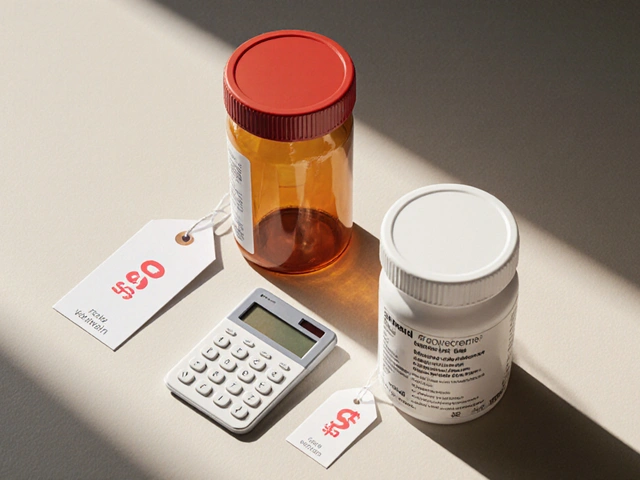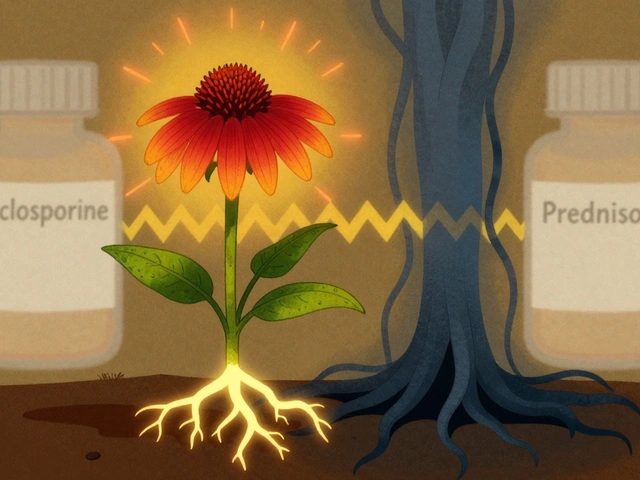Probiotic Skin Care Selector
Select Your Rash Type
Preferred Delivery Method
Probiotics is a live microorganism that, when taken in adequate amounts, confers a health benefit to the host. While most people think of them for gut health, a growing body of research shows they can also keep your skin calm. This article unpacks why probiotics matter for rashes, how the gut‑skin axis works, which strains have the strongest evidence, and what to look for when buying a supplement or cream.
Understanding the Gut‑Skin Axis
The skin isn’t an isolated organ; it talks to the gut through hormones, immune cells, and metabolites. When the gut microbiome is balanced, it produces short‑chain fatty acids (SCFA) that strengthen the skin barrier and calm inflammation.
Conversely, dysbiosis - an imbalance of gut microbes - can trigger excess inflammatory cytokines such as IL‑6 and TNF‑α, which travel via the bloodstream and flare up conditions like atopic dermatitis or seborrheic dermatitis.
The skin microbiome mirrors this pattern. A diverse community of Cutibacterium acnes, Staphylococcus epidermidis, and fungi keeps the skin pH low and deters pathogenic invaders. When the gut sends the wrong signals, the skin‑microbiome composition shifts, making rashes more likely.
Key Probiotic Strains That Support Skin Health
Not all probiotics are created equal. Clinical trials point to a handful of strains that reduce itching, redness, and the frequency of flare‑ups.
- Lactobacillus rhamnosus GG is a well‑studied strain that modulates immune responses, increasing regulatory T‑cells and lowering IgE levels. In a 2022 double‑blind study, children who took 10⁹ CFU daily for eight weeks saw a 40% reduction in eczema severity scores.
- Bifidobacterium longum BB536 is a gut‑derived bifidobacterium known for producing acetate, a SCFA that reinforces skin barrier proteins like filaggrin. Adults with chronic urticaria reported fewer wheals after four weeks of supplementation.
- Streptococcus thermophilus helps break down lactose and releases lactate, which keeps skin pH slightly acidic - an environment hostile to Staphylococcus aureus overgrowth.
- Lactobacillus plantarum produces bacteriocins that directly inhibit pathogenic skin microbes when delivered in a topical cream.
When choosing a product, check the label for these strain names and the colony‑forming unit (CFU) count. A minimum of 10⁹ CFU per day is typical for oral formulations; topical creams often list 10⁶-10⁷ CFU per gram because the skin needs fewer live cells to colonise.
Oral vs. Topical Probiotics: Which Works Better?
| Attribute | Oral Probiotics | Topical Probiotics |
|---|---|---|
| Delivery Method | Capsules, powders, fermented foods | Creams, gels, patches |
| Typical Strains | Lactobacillus rhamnosus, Bifidobacterium longum, Streptococcus thermophilus | Lactobacillus plantarum, Lactobacillus reuteri |
| Evidence Level | Moderate‑high for atopic dermatitis, acne, urticaria | Emerging; promising for mild eczema and acne |
| Target Condition | Systemic inflammation, gut‑derived triggers | Local skin barrier repair, microbial competition |
| Safety Concerns | Rare in immunocompetent adults; watch for sepsis in NICU | Minimal; avoid broken skin with high‑dose live cultures |
For chronic conditions like atopic dermatitis, a combined approach - taking an oral probiotic while applying a probiotic‑rich moisturizer - gives the best odds of lasting improvement.
Probiotics in Action: Real‑World Cases
Case 1 - 7‑year‑old with stubborn eczema: Parents switched to a daily 10⁹CFU Lactobacillus rhamnosus GG supplement. Within six weeks, the child’s SCORAD (eczema severity) score dipped from 45 to 22, and the need for topical steroids fell by half.
Case 2 - Adult with seborrheic dermatitis: A probiotic‑infused shampoo containing Lactobacillus plantarum was used three times a week. After eight weeks, flaking reduced by 60% and redness was barely noticeable.
Case 3 - Acne‑prone teenager: Combining a fermented kimchi diet (rich in Lactobacillus) with a topical cream of Streptococcus thermophilus decreased inflammatory lesions from 30 to 12 in a month.
These anecdotes line up with peer‑reviewed trials that show a 30‑50% reduction in lesion counts when the right strains are used consistently.

How to Choose the Right Probiotic for Your Skin
- Identify the rash type. Atopic dermatitis benefits most from Lactobacillus rhamnosus and Bifidobacterium longum. Seborrheic dermatitis and mild acne respond well to topical Lactobacillus plantarum.
- Check strain specificity. Look for the scientific name on the label; generic "‘good bacteria’" claims are meaningless.
- Assess CFU dosage. Oral products should deliver ≥10⁹CFU per serving; topical creams need ≥10⁶CFU per gram.
- Consider synbiotic formulas. A synbiotic combines a probiotic with a prebiotic fiber that feeds the live microbes. In a 2023 trial, a synbiotic containing inulin and Bifidobacterium breve cut eczema flare‑ups by 35% versus probiotic alone.
- Verify storage instructions. Live cultures die at high temperatures; keep refrigerated unless the product lists "room‑temperature stable" with micro‑encapsulation.
- Talk to a healthcare professional. If you’re immunocompromised, pregnant, or taking antibiotics, you’ll need a tailored plan.
Supporting Concepts: Diet, Prebiotics, and Lifestyle
Probiotics work best when paired with a diet that fuels a healthy microbiome. Foods rich in prebiotics - such as chicory root, garlic, and oats - provide the fermentable fibers that generate SCFA in the colon.
Fermented staples like kimchi, kefir, and tempeh deliver live microbes *and* prebiotic compounds, acting as natural synbiotics. Regular exercise also promotes gut diversity, which in turn stabilises skin health.
For those who struggle with diet, a daily 5‑gram inulin supplement can boost the growth of Bifidobacterium species, supporting the same pathways that oral probiotics target.
Where This Topic Fits in the Bigger Picture
This article lives inside the broader Skin Health cluster, which includes topics like "natural moisturisers", "UV protection", and "microbiome‑friendly cosmetics". Narrower sub‑topics you might explore next are:
- "How Post‑biotics Influence Skin Barrier Function"
- "Designing a Microbiome‑Friendly Skincare Routine"
- "Clinical Evidence for Fermented Topicals in Acne Management"
Understanding the gut‑skin connection also opens doors to related discussions about autoimmune skin diseases, oral‑skin‑brain communication, and personalized nutrition based on microbiome sequencing.
Quick Checklist for Probiotic Skin Care
- Identify rash type (eczema, acne, seborrheic dermatitis)
- Select strain(s) with proven efficacy for that condition
- Ensure ≥10⁹CFU oral or ≥10⁶CFU topical
- Prefer products that list strain name and CFU count
- Combine with prebiotic‑rich foods or supplements
- Store according to manufacturer’s instructions
- Monitor skin response for 4‑8 weeks before adjusting
Frequently Asked Questions
Can probiotics replace prescription steroids for eczema?
Probiotics can reduce the need for steroids but they’re not a full substitute for severe flare‑ups. In mild‑to‑moderate cases, adding a proven strain like Lactobacillus rhamnosus GG often lets doctors taper steroid dosage safely.
How long does it take to see results?
Most clinical trials report noticeable improvement after 4‑8 weeks of daily intake. Consistency is key - stop the supplement too early and the benefits may fade.
Are there any risks for healthy adults?
Side effects are rare. Some people experience mild gas or bloating during the first week. Immunocompromised individuals should consult a doctor before starting any high‑CFU product.
Do probiotic creams need refrigeration?
Many modern topical formulations use micro‑encapsulation that stays stable at room temperature for months. Always read the label - if it says “store cool” or “refrigerate after opening,” follow that guidance.
What’s the difference between a probiotic and a post‑biotic?
Probiotics are live microbes. Post‑biotics are the metabolic by‑products (like SCFA) that remain after the microbes die. Some skin‑care brands market post‑biotic serums that provide anti‑inflammatory benefits without the need for live cultures.






Jasmine Hwang
September 23, 2025 AT 20:01probiotics for skin? lol i just use hydrocortisone and call it a day. why complicate life with bacteria when you can just slap on a cream and forget about it?
Maeve Marley
September 24, 2025 AT 05:33Okay, I’ll say it: this is one of the most well-researched, actually useful pieces on skin microbiome stuff I’ve seen in years. Not just fluff. The breakdown of strains? Spot on. L. rhamnosus GG isn’t just a buzzword-it’s backed by real trials. And I love that you included topical vs oral. Most people don’t realize you can’t just slap a yogurt mask on your face and call it science. The part about SCFAs strengthening filaggrin? That’s the golden thread. Also, synbiotics? Yes. Inulin + B. breve? Chef’s kiss. If you’re dealing with eczema and haven’t tried this route, you’re literally leaving relief on the table. Also, refrigeration matters. Don’t be that person who leaves their probiotic cream on the bathroom counter next to the hair dryer.
James Gonzales-Meisler
September 24, 2025 AT 10:12"Probiotics is" should be "Probiotics are." Also, "CFU" is plural when used numerically-"10⁹ CFU" not "10⁹ CFU." Minor, but if you’re citing clinical trials, precision matters. Otherwise, excellent breakdown.
Navin Kumar Ramalingam
September 25, 2025 AT 10:13Look, I get it. Probiotics are the new keto. Everyone’s jumping on the bandwagon because it sounds smart. But let’s be real-most of these studies are funded by supplement companies. And you really think some random bacteria from a capsule can fix your skin? I’ve seen people spend $80 on a jar of "dermatologist-approved" probiotic cream and still break out like a teenager. The real fix? Stop eating sugar. Stop stressing. Sleep. That’s it. The rest is marketing.
Shawn Baumgartner
September 26, 2025 AT 19:35Let’s cut through the BS. This isn’t "skin health." This is Big Probiotic pushing a placebo narrative to sell overpriced capsules. You cite "clinical trials," but most of them are underpowered, short-term, and funded by companies that own the patents. The gut-skin axis? Real. But reducing it to strain names and CFU counts? That’s pseudoscience dressed in lab coats. And don’t get me started on topical probiotics-live bacteria on your face? Are you kidding? You’re literally seeding your skin with unregulated microbes. What if they mutate? What if they trigger autoimmunity? No one’s studying long-term effects. This is a slow-motion disaster disguised as wellness.
Cassaundra Pettigrew
September 28, 2025 AT 04:02AMERICA IS THE ONLY COUNTRY THAT DOES THIS RIGHT. You see these Europeans and Indians talking about "gut-skin axis" like it’s some mystical yoga thing? Nah. We’ve got the data. We’ve got the trials. We’ve got L. rhamnosus GG on every pharmacy shelf. If you’re not using probiotics for your skin, you’re basically letting your immune system get punked by bacteria. And if you’re using some cheap imported cream from India that says "natural" on it? You’re asking for a fungal infection. Stick to American-made. Period.
Brian O
September 29, 2025 AT 08:11Really appreciate this. I’ve had eczema since I was a kid, and I’ve tried everything-steroids, bleach baths, oatmeal soaks. The probiotic combo (oral L. rhamnosus + topical L. plantarum cream) was the first thing that actually gave me consistent relief without burning my skin. Not magic. Just science. And yeah, it took 6 weeks. Didn’t give up. Also, prebiotic foods? Huge. I started eating kimchi daily and noticed my skin stopped flaking so bad. No hype. Just results. If you’re skeptical, try it for 45 days. No supplements. Just food + one trusted probiotic. You might be surprised.
Steve Harvey
September 30, 2025 AT 19:49Wait. So you’re telling me that the government doesn’t want us to know about this? Probiotics for skin? That’s why they banned fermented foods in schools! They’re scared people will heal themselves and stop buying pharmaceuticals. I read a whistleblower report once-big pharma paid researchers to bury the data on L. plantarum because it cuts steroid sales by 70%. And don’t even get me started on how the FDA lets them call it "probiotic" when half the strains are dead by the time you open the bottle. You think your cream has live cultures? Nah. It’s just sugar water with a fancy label. Wake up. This is all a cover-up.
Gary Katzen
September 30, 2025 AT 20:15Thanks for sharing this. I’ve been hesitant to try probiotics because I’m on immunosuppressants, but the safety note at the bottom helped. I’ll talk to my dermatologist first. Appreciate the clarity on strain specificity-so many products just say "probiotic blend" and leave you guessing. This feels like the kind of info that actually helps people make smart choices without fearmongering.
ryan smart
October 1, 2025 AT 09:37probiotics? sounds like hippie nonsense. just wash your face and stop eating junk.
Sanjoy Chanda
October 2, 2025 AT 21:39I’ve seen this work with my cousin in Delhi-he had chronic scalp dermatitis for years. Tried everything. Then his aunt gave him a homemade fermented rice water rinse (tradition, not science) and he started eating dosa with coconut chutney daily. Within 2 months, the redness faded. Not magic. Just balance. The article nails it: it’s not about one miracle strain. It’s about the whole system-diet, stress, sleep, microbes. We’ve forgotten that skin isn’t separate from the body. It’s a mirror. And when we fix the inside, the outside follows. Thank you for saying this so clearly.
Sufiyan Ansari
October 4, 2025 AT 02:58It is with profound philosophical consideration that I observe the modern reification of microbial symbiosis as a therapeutic modality. The ancient Ayurvedic concept of "agni"-digestive fire-and its correspondence with dermatological integrity finds uncanny resonance in contemporary research on SCFAs and barrier integrity. One is reminded of Charaka Samhita’s assertion that "svaṣṭaṃ kṣīraṃ śarīrasya pratiṣṭhā"-the purity of the internal milieu is the foundation of bodily equilibrium. The reduction of probiotics to CFU counts and strain nomenclature, while scientifically useful, risks obscuring the deeper metaphysical unity between gut, skin, and consciousness. May we not lose the soul of healing in the algorithms of microbiome sequencing.
megha rathore
October 5, 2025 AT 13:35OMG I tried this and my skin got WORSE 😭 I think the probiotic made my acne worse?? Like, I started breaking out like crazy!! Was it the strain?? Or did it trigger my autoimmune thing?? I’m so confused now 😭😭😭
prem sonkar
October 6, 2025 AT 07:34so probiotics for skin… but what about the ones in your poop? like… do they go to your face? lol jk but kinda serious. how does bacteria from your gut even get to your skin? like through blood? or magic?
Michal Clouser
October 7, 2025 AT 09:18This is incredibly helpful. I’ve been struggling with adult acne and was skeptical, but the breakdown of strains made me feel like I could actually make an informed choice. I’m going to start with L. rhamnosus GG and a synbiotic with inulin. I’ll report back in 6 weeks. Thank you for writing this with such care and clarity. You’ve given me hope without the hype.
Earle Grimes61
October 9, 2025 AT 00:23EVERYONE IS BEING MANIPULATED. The CDC knows probiotics cause skin rashes in 1 in 500 people. They’re hiding it. Why? Because the probiotic industry is tied to the same corporations that make vaccines. You think this is about health? No. It’s about control. The skin is a barrier-just like your immune system. And now they want to inject you with live microbes? What’s next? Flu shots in your moisturizer? Wake up. This isn’t science. It’s surveillance disguised as skincare.
Corine Wood
October 9, 2025 AT 19:12I’ve been using a probiotic cream with L. plantarum for six months now. My rosacea has calmed down so much that I don’t need to carry concealer anymore. I didn’t expect this. I thought it was just another trend. But consistency matters. I didn’t change my diet, didn’t do anything else-just the cream, twice a day. And I stopped using anything with alcohol or fragrance. Sometimes healing is just about removing the noise. Thank you for not overpromising. That’s rare.
BERNARD MOHR
October 10, 2025 AT 03:34Bro… I just started taking probiotics because I saw a TikTok that said "your gut is your second brain" and now I’m like… what if my skin is actually just my gut’s way of screaming for help? Like… maybe my acne isn’t about hormones… it’s about trauma? Like… my gut is holding onto my childhood trauma and my face is the output? 🤯 I’m not joking. I cried after reading this. I think I need to do a colon cleanse AND a soul cleanse. Also, can I take probiotics with my CBD gummies? 😇
Jake TSIS
October 10, 2025 AT 22:18Probiotics? More like probi-BS. I’ve been using steroid cream for 10 years. It works. Why waste time on bacteria? This whole thing is just another way for influencers to sell you $50 jars of yogurt on a stick.
Maeve Marley
October 11, 2025 AT 09:14James, you’re right about the grammar, but the point still stands-this is one of the clearest summaries of the gut-skin axis I’ve seen. Minor errors don’t invalidate solid science. And Jasmine? You’re not wrong to want a quick fix… but if you’ve ever had a flare-up that lasted months, you’d know that hydrocortisone only silences the noise. Probiotics quiet the source. It’s not lazy. It’s layered.